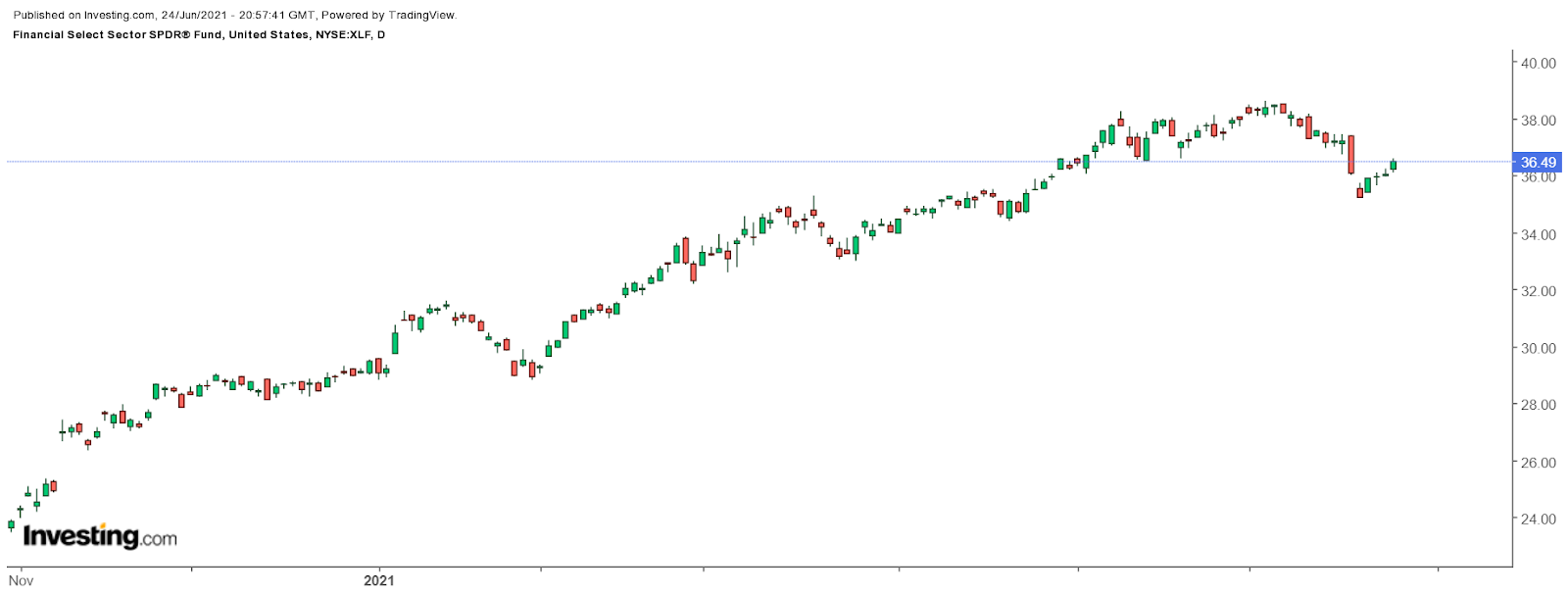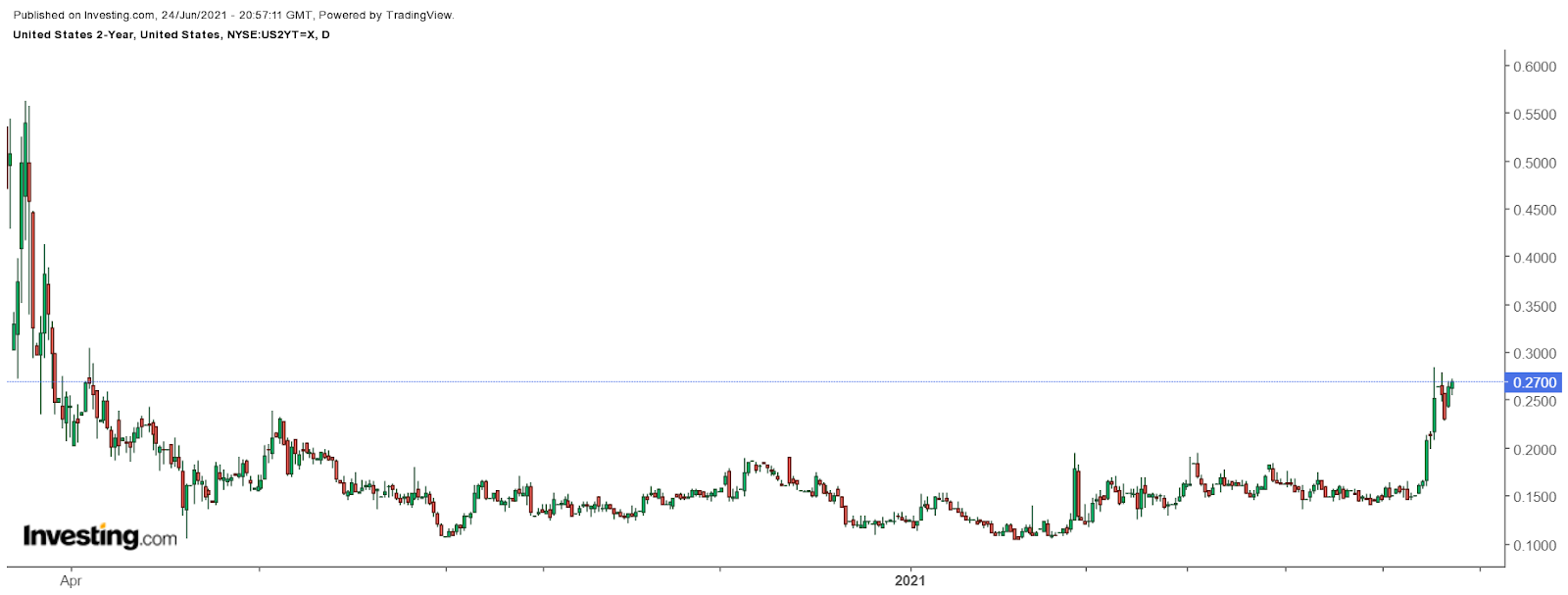
- All Instrument Types
- Indices
- Equities
- ETFs
- Funds
- Commodities
- Currencies
- Crypto
- Bonds
- Certificates
Please try another search

Is It Already Time To Think About A U.S. Recession?

This article was written exclusively for Investing.com
The market has a way of repeating history regularly, with triggers for the narrative always slightly different, but the moral of the story almost always the same. So it seems, given the recent curveball by the Fed at last week's FOMC meeting, the yield curve has gone from one of steepening to flattening. In the past, this action has tended to lead to worries of a potential recession.
Clearly, a flattening yield curve would make plenty of investors worry about an economy slowing. This would likely prompt investors to shy away from many of the reflation assets that have led the charge since the November elections. As a result, the bank, industrials, materials, and energy sectors would most likely see sharp declines.
Flatter Curve
The damage to the yield curve at this point hasn't been too horrible, but it was enough to send the Financial ETF (NYSE:XLF) sharply lower last week. It is now down around 5.25% from its peak on June 7. The 10-Year minus the 2-Year Treasury peaked at approximately 1.6% in early April and has since fallen to around 1.22%, a decline of about 40 bps. At first, the curve was flattening due to 10-year rates falling, but since the Fed last week, that move has accelerated with 2-year rates climbing to 26 bps, from 12 bps on June 15.
Short-End Will Need To Rise
Over time, the rising short-end and falling long-end of the curve will likely flatten further. It seems if the Fed is projecting 2 rate hikes by 2023, that the 2-year yield has much further to climb, potentially well above 60 bps. However, the 10-year has been falling for some time, indicating that the bond market doesn't see a long-term threat of inflation in the economy. The flattening curve would suggest that the bond market sees an economy slowing in the future, likely caused by tighter monetary policy.
Reflation Most Hurt
This would be a huge negative for the reflation trade in the stock market. These sectors have seen massive amounts of appreciation in recent months due to widening spreads and rising inflation expectations. However, the Fed has essentially reversed that trade entirely in its recent actions. Suppose spreads and inflation expectations continue to decline. In that case, this is likely to move over to the broader equity market, with the reflationary sectors seeing the most damage.
This story is repeated regularly, with a flattening yield curve constantly triggering worries among investors about the bond market's message. Of course, this isn't to say these worries are likely to develop today or tomorrow. Still, suppose that spread continues to flatten at some point; those worries are likely to develop. In that case, greater attention will be paid, eventually turning to the fears of slowing growth or, worse, concerns of a recession.
Watching the direction of that spread over the next several weeks could be crucial in determining which way equity investors rotate their holdings. The more the curve flattens, the more the strong rotations are likely to happen, the louder the worries of an economic slump will grow.
Related Articles

MON: Eurogroup Meeting, Norwegian CPI (Feb), EZ Sentix Index (Mar), Japanese GDP (Q4) TUE: EIA STEO WED: 25% US tariff on all imports of steel and aluminium comes into effect,...

Brief Reminder In 2018, US President Donald Trump initiated a trade war update with sanctions against China. Economic disagreement between the United States and China began in...

Trump’s U-Turns Keep the Market Under Pressure Both US equity indices and the US dollar remain under severe stress as US President Trump continues his back-and-forth on the...
Are you sure you want to block %USER_NAME%?
By doing so, you and %USER_NAME% will not be able to see any of each other's Investing.com's posts.
%USER_NAME% was successfully added to your Block List
Since you’ve just unblocked this person, you must wait 48 hours before renewing the block.
I feel that this comment is:
Thank You!
Your report has been sent to our moderators for review







Add a Comment
We encourage you to use comments to engage with other users, share your perspective and ask questions of authors and each other. However, in order to maintain the high level of discourse we’ve all come to value and expect, please keep the following criteria in mind:
Enrich the conversation, don’t trash it.
Stay focused and on track. Only post material that’s relevant to the topic being discussed.
Be respectful. Even negative opinions can be framed positively and diplomatically. Avoid profanity, slander or personal attacks directed at an author or another user. Racism, sexism and other forms of discrimination will not be tolerated.
Perpetrators of spam or abuse will be deleted from the site and prohibited from future registration at Investing.com’s discretion.